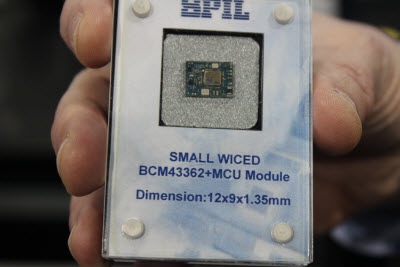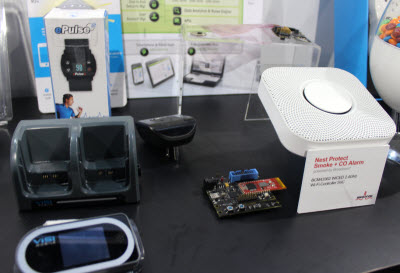If you were looking for this mythical “internet of things” at the 2014 International CES tech trade show last week, you didn’t have to go much farther than the Broadcom booth. When it comes to powering the internet of things or wearables, Broadcom specializes in it.

Above: Broadcom’s multi-protocol WICED chip
The communications chip maker had $8 billion in revenue in 2012 and it is charging into new markets for semiconductors. The backbone of the internet of things will depend on tiny processors, sensors, and communications devices that companies like Broadcom make. Broadcom makes chips that make things smarter, from cars to dog collars. So a tour of Broadcom’s chips gives us a window into the future of gadgets that will appear a year or two down the road.
We took that tour at CES with Scott McGregor, chief executive of Broadcom, which is competing with Intel and a bunch of other chip makers to lay the foundation for the internet’s future. Here’s an edited transcript of our interview about the opportunities that lie ahead.
VentureBeat: The internet of things is big. Wearables are big. What are the underlying technologies that have to be put into place for this next wave of whatever you call it – computing after the PC and after smartphones?
Scott McGregor: For wearables and the internet of things, the core technology is connectivity, because these are devices that enable connectivity for other things. We believe the right way to approach this market is around the core of connectivity, and we add to that integrated processors, integrated power management, memory, all those things. Sensor hub integration. We create a single device, which we call our WICED family, that has either Bluetooth or Wi-Fi or NFC or some combination of those.

Above: Broadcom chips power internet of things devices like Nest.
VB: You don’t necessarily care which one?
McGregor: No. We’re agnostic about what standards they use. For many devices, you have to think about whether it’s a cluster around your smartphone, or if it’s a cluster around your Wi-Fi access point, or if it’s broader than that. Many of these devices will use your smartphone to get out to the internet. They do that to save on power and things like that. Bluetooth low energy is a perfect technology for that. Others—The NEST smoke detector is a great example. It uses Wi-Fi to create a mesh net where they all communicate and transmit information.
We see different kinds of protocols and standards for different kinds of products, based on the range and the use model. Wearables tend to be more Bluetooth-related. Things like your refrigerator will use more of a Wi-Fi connection. Our goal is to create single devices that integrate everything you need to build to the internet-of-things connection. We want to make that affordable and low-power and small and reliable.
This is Bluetooth and a processor and power management and memory and the analog bits to do an internet-of-things or wearable device. If you wanted to do a watch or some other type of device like that, it’s everything you need. It’ll run on a coin cell for a year or more. Very integrated, very easy to do. It’s an FCC-certified module, so it makes it easy for people, even smaller companies, to get to market very quickly.

Above: Broadcom chips power the iGrill
We have some examples of applications here, just a few cool ones. You’re familiar with the watches. Garage doors. Intelligent light bulbs. Lots of intelligent outlets. This one, you can change the color remotely. Hearing aids. This is the iGrill. You’re watching the football game inside and you stick this in the meat on your grill. It uses wireless LAN to talk to your smartphone and tell you what temperature the steak is.
VB: I saw a basketball with sensors in it.
McGregor: Football helmets, we’ve got one of those. It does impact detection and measurement. These are just some examples of the things we’re working on. They show the kinds of technologies you want to have in there.
We have some competitors who view this as a processor problem or something else like that. We view it as an integrated system. We provide everything in one piece. We’re seeing pretty good traction there. Would you like to see automotive, or 4K by 2K, HEVC?
VB: Is there anything new on location?
McGregor: Absolutely. This is GPS and navigation. We’re putting it into very small devices and wearables, so they have location. This here is really cool. Broadcom and Verizon will be announcing this. It’s a way to use Wi-Fi to very accurately – within a meter, a meter and a half – tell where you are located indoors, using what you already have in your smartphone. Very low power. It doesn’t require GPS or anything like that.

Above: Broadcom chips and OmniTrail software power this “precise presence” retail demo.
Stores could use this for customer loyalty and other kinds of things. Let’s say you entered a Verizon store. They would know who you are and that you’re eligible for a free upgrade today. What Verizon wants to do, using technology from OmniTrail that we’ve implemented in the firmware on our chips, is to enable their enterprise networking customers and retailers to create this opportunity and make offers to customers.
Companies that produce multiple devices, for the home and for mobile – let’s say Samsung, for instance – could benefit from this in their device ecosystem. You enter your house. The television changes channels. The thermostat sets itself. All sorts of events could happen.
VB: Your watch could tell you that you have a deal coming your way.
McGregor: Think of it as something consumer-friendly, too. I like the idea of my home setting itself to the right temperature, or fixing the ambient light how I like it. The trick is, you can do this with other technologies, but this will come already enabled with the Wi-Fi stuff you have in your phone. The access points are able to determine it all.
